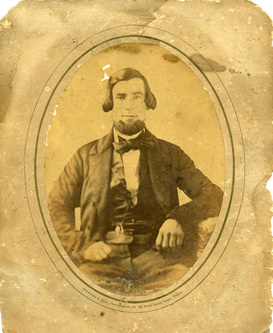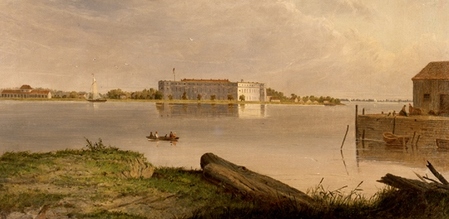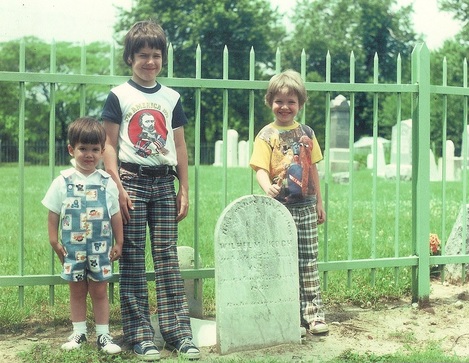"What's in a Name?"
-by Chris Haugh
William Shakespeare made these lines immortal in his legendary tale of star-crossed lovers named Romeo & Juliet. The question within the quote (“What’s in a name?”) is still regularly used today as a popular adage expressing the point that the name or label we put on things or persons may vary, but these can still accurately describe the subject at hand. Simply put: “It is what it is” and “You are what you are.” Ironically, a perceived “ladies’ man” of today is often labeled as a “Romeo,” and defined as an attractive, passionate male seducer or lover. I’m sure Shakespeare would be proud! It’s all about perceptions and connections—finding, making and understanding these between things, places and people.

That said, I chose to name this history-based freelance/consulting business of mine: History Shark Productions. It's really nothing more than a fancy synonym forChris Haugh Productions, but there is a rhyme and reason for this which I will get to shortly. And just in case you were wondering, the rationale is not because the domain name for Chris Haugh Productions was already taken. I was amazed to Google it for myself, and several articles/references to me seem to appear in the search results. A very good problem to have.

We often find that the special people in our lives go by several names with some of these being traditional familial titles. A “mature” adult woman named Cynthia may also be personally referenced in a variety of ways: Cindy by her siblings/friends, “Cin” by her husband, mom by her kids, grand-mom by her grandchildren, and Aunt Cindy by nieces and nephews. Perhaps Cynthia is actually this woman’s middle name, as her parents gave her the legal name of Beatrice Cynthia when she was born? Each “synonymic” label dictates, and often possesses, a varied relationship with the particular “name caller.” However, our Cynthia is still one in the same, the sum of all these names...just like “Shakespeare’s rose.”
In the workforce, prefixes attached to surnames are regularly used, along with titles based on rank or vocation. Our Cynthia Jones could be a teacher known by her students as Mrs. Jones. She could also become Dr. Jones, Principal Jones, Superintendent Jones, Dean Jones or President Jones. Throw in additional opportunities in a military or law enforcement career and Cynthia becomes Officer Jones, Sergeant Jones or Lieutenant Jones. In fact, she may also be known by a series of other nicknames given by both friends and relatives alike, some dating back to childhood. An obvious choice is “Jonesy.” But more creative and evocative names could pertain to a personal trait, characteristic, or ridiculous life moment. Perhaps Cynthia would feel a bit sheepish having to explain given monikers such as: “Cinner,” “Cinny Blue Eyes,” “Bootsie,” “The Liquidator,” or “Lil' Toot-Toot?”
So, what’s really in a name? Interestingly enough, a great deal! All these labels refer to the same person, and in many cases, very few individuals (outside of the self) actually know the “whole” person in which all names refer. It’s all about gaining a full picture and greater context of a person and their life. For many of us, this thought is often experienced as we sit and listen to eulogies at a funeral, especially when delivered by varying orators. Of course family members can provide some of the most complete descriptions, but what if the “deceased” had moved/lived away from the main family for most of their life? An adult friend can paint a different picture of someone compared to a childhood friend. What of an old war buddy, fraternity brother or college teammate? A former teacher or boss may also have quite a different story to tell on the individual than a later job co-worker, fitness class instructor, or fellow volunteer at the local food bank. By hearing several voices at a funeral, we are usually left with the “a-ha moment” and feeling that we truly didn’t know all facets of the “dearly departed.”
Let’s go back to names for a minute. I, myself, have always gone with the shortened nickname version of my legal name Christopher—Chris. Of course, Christopher usually finds its use best in formal settings, but also harkens back to childhood in which I shuttered to hear my full name annunciated by my parents. This usually meant there was impending punishment to be had as I must have done something wrong—the dreaded “Christopher Edwin Haugh! Come down here this very minute!”
In the workforce, prefixes attached to surnames are regularly used, along with titles based on rank or vocation. Our Cynthia Jones could be a teacher known by her students as Mrs. Jones. She could also become Dr. Jones, Principal Jones, Superintendent Jones, Dean Jones or President Jones. Throw in additional opportunities in a military or law enforcement career and Cynthia becomes Officer Jones, Sergeant Jones or Lieutenant Jones. In fact, she may also be known by a series of other nicknames given by both friends and relatives alike, some dating back to childhood. An obvious choice is “Jonesy.” But more creative and evocative names could pertain to a personal trait, characteristic, or ridiculous life moment. Perhaps Cynthia would feel a bit sheepish having to explain given monikers such as: “Cinner,” “Cinny Blue Eyes,” “Bootsie,” “The Liquidator,” or “Lil' Toot-Toot?”
So, what’s really in a name? Interestingly enough, a great deal! All these labels refer to the same person, and in many cases, very few individuals (outside of the self) actually know the “whole” person in which all names refer. It’s all about gaining a full picture and greater context of a person and their life. For many of us, this thought is often experienced as we sit and listen to eulogies at a funeral, especially when delivered by varying orators. Of course family members can provide some of the most complete descriptions, but what if the “deceased” had moved/lived away from the main family for most of their life? An adult friend can paint a different picture of someone compared to a childhood friend. What of an old war buddy, fraternity brother or college teammate? A former teacher or boss may also have quite a different story to tell on the individual than a later job co-worker, fitness class instructor, or fellow volunteer at the local food bank. By hearing several voices at a funeral, we are usually left with the “a-ha moment” and feeling that we truly didn’t know all facets of the “dearly departed.”
Let’s go back to names for a minute. I, myself, have always gone with the shortened nickname version of my legal name Christopher—Chris. Of course, Christopher usually finds its use best in formal settings, but also harkens back to childhood in which I shuttered to hear my full name annunciated by my parents. This usually meant there was impending punishment to be had as I must have done something wrong—the dreaded “Christopher Edwin Haugh! Come down here this very minute!”
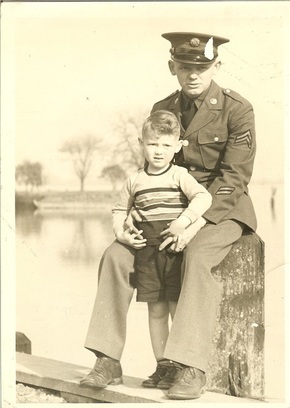 Edwin A. Haugh, Sr. and Edwin A. Haugh, Jr. along the Chesapeake & Delaware Canal in Delaware City (c.1941)
Edwin A. Haugh, Sr. and Edwin A. Haugh, Jr. along the Chesapeake & Delaware Canal in Delaware City (c.1941)
Our middle names can say a lot about us as well. I’m particularly interested in the family connections or homage paid with these. Certainly, explaining a name given in honor of a parent, relative or special individual makes for a better story than those individuals given their middle name based on popularity trends of the day, or worse yet, a sing-songy practicality based on syllabic measure. (I’d like to note here that my parents made sure my brothers and I each had the 3-2-1 syllable name sequence, as I guess it was a fad in the late 1960’s?)
My middle name is Edwin. This was my father’s name (Edwin Albert Haugh, Jr.), and also my grandfather’s name (Edwin Albert Haugh, Sr.) Unfortunately, I have not been able to trace the origin back earlier as my great-grandfather in this genealogy branch was Ambrose Albert Haugh, son of Jason Ambrose Haugh, an Irish immigrant who came to America in the 1870’s. So I guess it’s conceivable that I could have received the middle name Albert or Ambrose if Edwin hadn’t have been favored in my case. In doing research, I discovered that one of my great-grandfather’s close work associates was named Edwin—perhaps this is the origin?
My middle name is Edwin. This was my father’s name (Edwin Albert Haugh, Jr.), and also my grandfather’s name (Edwin Albert Haugh, Sr.) Unfortunately, I have not been able to trace the origin back earlier as my great-grandfather in this genealogy branch was Ambrose Albert Haugh, son of Jason Ambrose Haugh, an Irish immigrant who came to America in the 1870’s. So I guess it’s conceivable that I could have received the middle name Albert or Ambrose if Edwin hadn’t have been favored in my case. In doing research, I discovered that one of my great-grandfather’s close work associates was named Edwin—perhaps this is the origin?
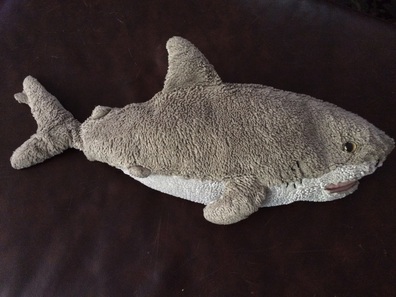 The legendary "Sharky" the shark
The legendary "Sharky" the shark
I experienced fatherhood a little later in life than most at 39 years-old. Call me old fashioned, but my wife and I thought it would be fun not knowing the sex of our child until "he" or "she" was born. During our many well-visits, the perinatal nurses and doctors referred to our imminent spawn simply as “Baby.” Then I noticed my wife doing the same thing at home. I mentioned that the kid, regardless of gender, deserved something a little less generic than being called “Baby.”
She said, ”Like what?”
I thought for a moment and said, “How about something tough, yet meaningful and thought-provoking?“
She replied that it couldn’t be gender specific.
I thought for a moment and exclaimed, “Sharky!”
She laughed and agreed that I had successfully met the requirements.
I quickly retorted that it was more fitting to say,“Hey Sharky, you swimming around in there?” in deference to“Hi Baby! You aren’t in a corner are you?”
The name stuck, and would continue through infancy into our child’s toddler years. That was over nine years ago, and my son, Edwin Sebastian Haugh, still sleeps with a plush 18” stuffed animal shark that he received at birth, aptly named “Sharky” as well.
She said, ”Like what?”
I thought for a moment and said, “How about something tough, yet meaningful and thought-provoking?“
She replied that it couldn’t be gender specific.
I thought for a moment and exclaimed, “Sharky!”
She laughed and agreed that I had successfully met the requirements.
I quickly retorted that it was more fitting to say,“Hey Sharky, you swimming around in there?” in deference to“Hi Baby! You aren’t in a corner are you?”
The name stuck, and would continue through infancy into our child’s toddler years. That was over nine years ago, and my son, Edwin Sebastian Haugh, still sleeps with a plush 18” stuffed animal shark that he received at birth, aptly named “Sharky” as well.
The personal nickname of “Sharky” has fallen by the wayside and Edwin is commonly known to most friends and relations as “Eddie,” just like my father was called by anyone knowing him before adulthood. When my dad finished school and entered the working world, he preferred “Ed.” Sadly, Dad never got to meet his grandson Eddie as he died two years before the latter was born. Interestingly, my Eddie looks very much like his namesake, including his brownish-red hair, freckles and fair coloring. My father’s favorite activity was going to the beach—same as my young son, and myself for that matter. I truly feel the “bridge of life” concept, buttressed on both sides by Eddie Haughs.
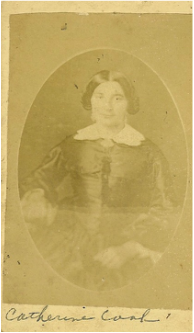 Catherine Sebastian (1832-1912)
Catherine Sebastian (1832-1912)
How did my son come to acquire the middle name of Sebastian?
I wouldn't be wrong in simply saying, "It's French!" The name, however, is not attributed to St. Sebastian, the famed martyr, nor does it pay homage to the great English film and television actor Sebastian Cabot. Ironically, Cabot is best known for his role as Mr. French on the sitcom Family Affair (1966-1971). Sebastian is the surname of a devoutly Catholic French ancestor in this case, my paternal GGG Grandmother from Alsace-Lorraine who arrived in America in 1852. At the age of 19, Catherine Sebastian had left a battered homeland behind, one contested regularly by both France and Germany.
Family lore says that Catherine and her sister dressed as boys in an effort to smuggle their father and uncle out of their country en-route to the US. The Sebastian family would escape and disembark in New York City. Her sister would remain there, while a brother reportedly traveled west. Catherine eventually came to Delaware, perhaps in an effort to find work, or simply accompanied her future spouse. Relatively little is known about the Sebastian family as more concentration over the years has centered on her husband and his journey to America from Herborn, Germany.
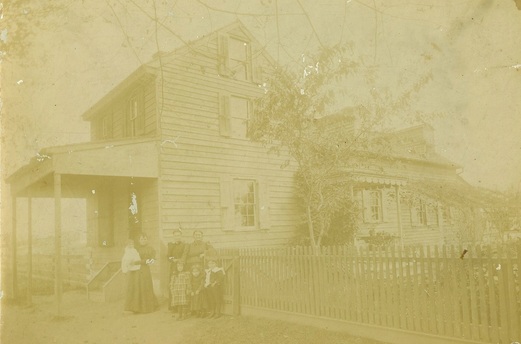 Cook family home on East 5th Street in Delaware City, Delaware (c. 1898)
Cook family home on East 5th Street in Delaware City, Delaware (c. 1898)
Wilhelm's passing left wife Catherine Sebastian (Koch) Cook with two toddler boys to raise (ages 4.5 and 1.5). She would give birth to a third child, a daughter named Elizabeth Anna, in June, 1862, two months after her husband’s death. She raised all three children into adulthood, never remarrying. Special attention had to be given to daughter Elizabeth who, at age four, endured an unfortunate fall that crippled her for the rest of her life.
Catherine made ends meet by working, first as a cook and laundress at Fort Delaware. A few years later, she “labored” as a midwife, a job that enabled her to buy a house in which to raise her family. Later in life, she operated a small general store out of this house’s front parlor.
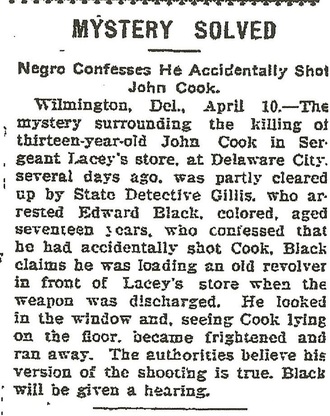 Article about John Cook's death that appeared in the Frederick News, April 10, 1908
Article about John Cook's death that appeared in the Frederick News, April 10, 1908
Catherine’s two younger children remained in the family home into adulthood. Daughter Elizabeth, finally able to walk at age 16, greatly benefitted from her mother's care. Son John Cook, my direct relative and GG grandfather, married at age 30. His new bride Emma would move into this home and bring six more children over the next ten years—all delivered in part by their midwife grandmother Catherine. Speaking of names, my great-grandmother was given the name "Zitta," which appears to mean happy state, young woman.
Divine provenance would come into play, providing Catherine, the "French Rose," with a new, yet familiar life role in 1901. Her daughter-in-law Emma (my GG Grandmother) died of whooping cough at the age of 39—ironically the same age I began parenting. Catherine unselfishly helped her son John raise these grandchildren into adulthood. Both mother and son were aided by “Auntie,” Elizabeth Cook. Yet another tragedy would beset the family in April, 1908, when 13 year-old grandson John Cook was accidentally shot and killed as he stood harmlessly in the front parlor store area of the family home. This story made newspaper headlines up and down the East Coast, and certainly called Catherine's strength once again to hold the family together. After an investigation, it was found that the bullet came from the gun of a gentleman who was hunting along the canal.
Divine provenance would come into play, providing Catherine, the "French Rose," with a new, yet familiar life role in 1901. Her daughter-in-law Emma (my GG Grandmother) died of whooping cough at the age of 39—ironically the same age I began parenting. Catherine unselfishly helped her son John raise these grandchildren into adulthood. Both mother and son were aided by “Auntie,” Elizabeth Cook. Yet another tragedy would beset the family in April, 1908, when 13 year-old grandson John Cook was accidentally shot and killed as he stood harmlessly in the front parlor store area of the family home. This story made newspaper headlines up and down the East Coast, and certainly called Catherine's strength once again to hold the family together. After an investigation, it was found that the bullet came from the gun of a gentleman who was hunting along the canal.
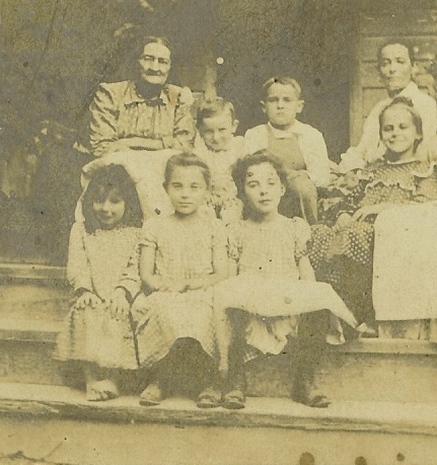 Catherine Sebastian Cook (back row left) and her grandchildren in 1901. She is joined by "Auntie" Elizabeth (back row right). young John Cook to Elizabeth's left and Zitta is seated (first row left) in front of her grandmother.
Catherine Sebastian Cook (back row left) and her grandchildren in 1901. She is joined by "Auntie" Elizabeth (back row right). young John Cook to Elizabeth's left and Zitta is seated (first row left) in front of her grandmother.
Catherine Sebastian Cook died in early May 1912, at the age of 73. She never won any medical awards, her "general store" business model didn’t franchise, no books have been written about her—just an average life filled at times with challenges, but one of happiness and optimism.
Catherine Sebastian has always been idyllic to me, since hearing my grandmother tell stories about her. My father re-enforced the admiration even further. While in college, he conducted a family lineage assignment for his History minor at the University of Delaware. This was in the mid 1950’s and he had the opportunity to interview his own grandmother and her siblings about life with their parents and especially their beloved grandmother and family patriarch—Catherine Sebastian Cook.
And wouldn’t you know it, through reopening my own genealogical research on this intriguing woman, I found two major things: 1.) Her name had been spelled with both a "C" (Catherine) and a "K" (Katherine); and 2.) Catherine was actually her middle name! She declined to use her true given first name of Madeliene in favor of her middle name, also French in origin, and said to mean pure and clear. So again, I implore to ask the question, “What’s in a name?”
Catherine Sebastian has always been idyllic to me, since hearing my grandmother tell stories about her. My father re-enforced the admiration even further. While in college, he conducted a family lineage assignment for his History minor at the University of Delaware. This was in the mid 1950’s and he had the opportunity to interview his own grandmother and her siblings about life with their parents and especially their beloved grandmother and family patriarch—Catherine Sebastian Cook.
And wouldn’t you know it, through reopening my own genealogical research on this intriguing woman, I found two major things: 1.) Her name had been spelled with both a "C" (Catherine) and a "K" (Katherine); and 2.) Catherine was actually her middle name! She declined to use her true given first name of Madeliene in favor of her middle name, also French in origin, and said to mean pure and clear. So again, I implore to ask the question, “What’s in a name?”
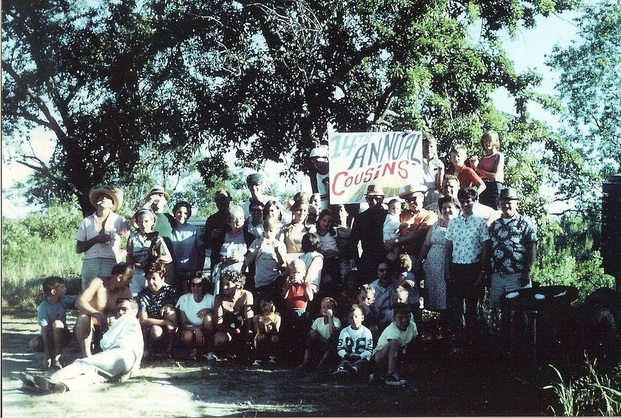 14th Annual Cook Cousins Picnic at Sam Green's Beach, Port Penn, Delaware in the summer of 1968. New family member Chris Haugh (age 1.5) is held by his father underneath the sign as his grandparents and mother stand to the right.
14th Annual Cook Cousins Picnic at Sam Green's Beach, Port Penn, Delaware in the summer of 1968. New family member Chris Haugh (age 1.5) is held by his father underneath the sign as his grandparents and mother stand to the right.
Wilhelm Koch Ieft his lasting legacy with the family surname. However it was actually Catherine who gave the Cook name such special meaning to me and countless relatives over the past 150 years. She is responsible for the family's personality and loving nature, thanks in part to her life's example.
I have always marveled at the close knit relationship my father shared with his extended family of "Cook" cousins. His father, a transplant serviceman from New Jersey had been equally embraced, after marrying into the family.
This was a regular occurrence as many Cook family girls, including Catherine's three granddaughters, married soldiers once stationed at Fort DuPont, a military installation directly across the canal from their home on East 5th Street in Delaware City. This family culture was magical, something clearly evident through the four generations that followed Wilhelm and Catherine’s union back in the mid 1850’s. Many of those descendants still live in Delaware City to this day, others are spread around the country. I was able to experience the Cook Cousin spirit first-hand through family reunions, summer picnics, Christmas parties and even sad occasions such as post-funeral receptions for members who had passed on, including my own father.
I have always marveled at the close knit relationship my father shared with his extended family of "Cook" cousins. His father, a transplant serviceman from New Jersey had been equally embraced, after marrying into the family.
This was a regular occurrence as many Cook family girls, including Catherine's three granddaughters, married soldiers once stationed at Fort DuPont, a military installation directly across the canal from their home on East 5th Street in Delaware City. This family culture was magical, something clearly evident through the four generations that followed Wilhelm and Catherine’s union back in the mid 1850’s. Many of those descendants still live in Delaware City to this day, others are spread around the country. I was able to experience the Cook Cousin spirit first-hand through family reunions, summer picnics, Christmas parties and even sad occasions such as post-funeral receptions for members who had passed on, including my own father.
 Shark-related humor, one of many cartoons by Australian illustrator Phil Watson found on the site www.shaark.com
Shark-related humor, one of many cartoons by Australian illustrator Phil Watson found on the site www.shaark.com
History Shark Productions is the name I have chosen for my business handle. I know that you don’t often see sharks researching, writing about the past, or giving lectures. Rather the stereotypical view of this fish consists of them ending people’s lives, not documenting them.
All this aside, sharks, like history, are perceived differently by different people. But most experts concur that these are interesting animals, and can commonly be defined by the term voracious: meaning enthusiastic, eager, keen, avid, desirous, hungry, and ravenous. Now maybe the adjective “ravenous” may be a bit strong, but when it comes to assisting others with interpreting, understanding and documenting history, I can honestly describe myself as voracious—but always friendly and even-tempered, mind you.
All this aside, sharks, like history, are perceived differently by different people. But most experts concur that these are interesting animals, and can commonly be defined by the term voracious: meaning enthusiastic, eager, keen, avid, desirous, hungry, and ravenous. Now maybe the adjective “ravenous” may be a bit strong, but when it comes to assisting others with interpreting, understanding and documenting history, I can honestly describe myself as voracious—but always friendly and even-tempered, mind you.
Proudly powered by Weebly


